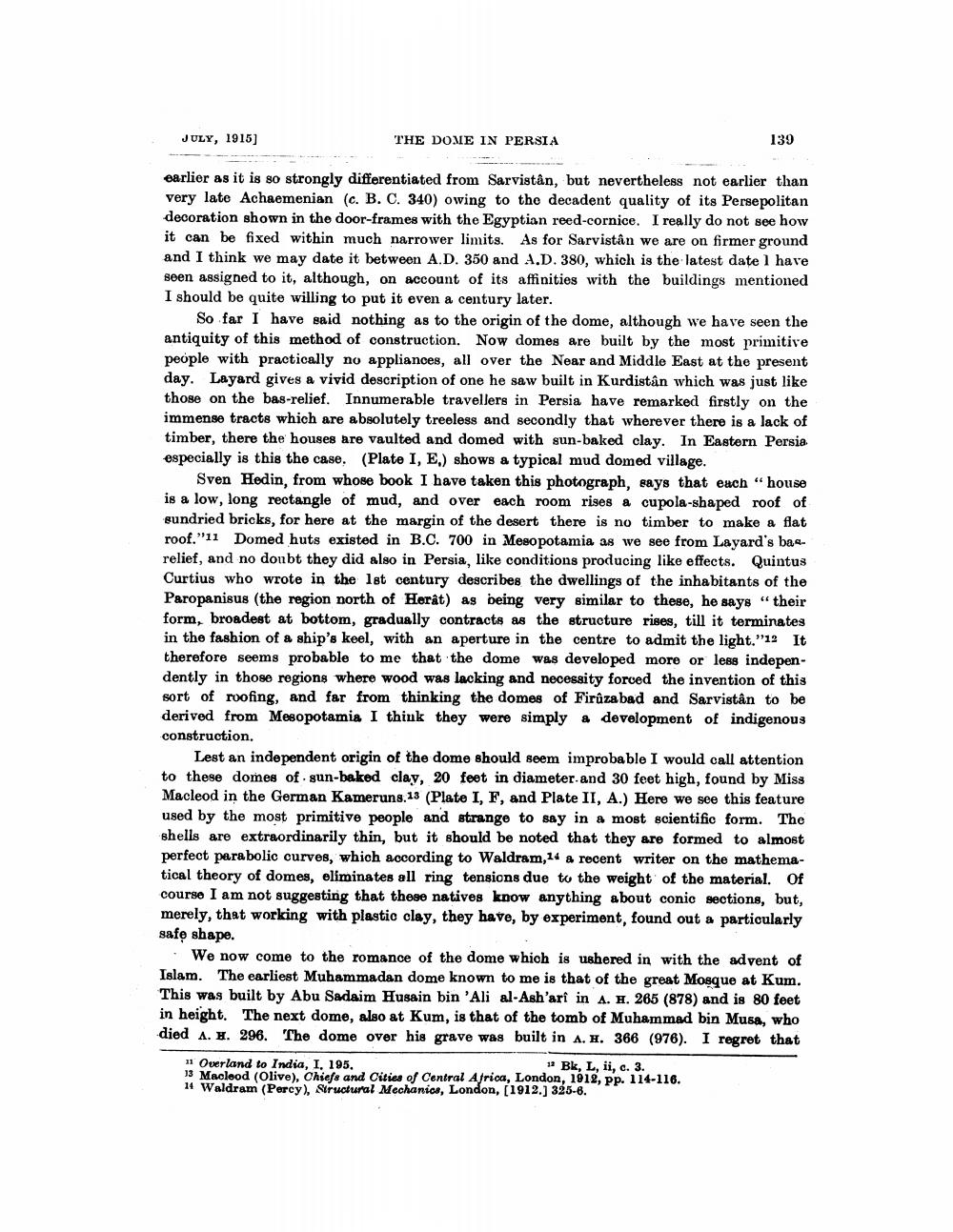________________
JULY, 1915]
THE DOME IN PERSIA
139
earlier as it is so strongly differentiated from Sarvistân, but nevertheless not earlier than very late Achaemenian (c. B. C. 340) owing to the decadent quality of its Persepolitan decoration shown in the door-frames with the Egyptian reed-cornice. I really do not see how it can be fixed within much narrower limits. As for Sarvistân we are on firmer ground and I think we may date it between A.D. 350 and A.D. 380, which is the latest date I have seen assigned to it, although, on account of its affinities with the buildings mentioned I should be quite willing to put it even a century later.
So far I have said nothing as to the origin of the dome, although we have seen the antiquity of this method of construction. Now domes are built by the most primitive people with practically no appliances, all over the Near and Middle East at the present day. Layard gives a vivid description of one he saw built in Kurdistân which was just like those on the bas-relief. Innumerable travellers in Persia have remarked firstly on the immense tracts which are absolutely treeless and secondly that wherever there is a lack of timber, there the houses are vaulted and domed with sun-baked clay. In Eastern Persia. especially is this the case. (Plate I, E,) shows a typical mud domed village.
Sven Hedin, from whose book I have taken this photograph, says that each "house is a low, long rectangle of mud, and over each room rises a cupola-shaped roof of sundried bricks, for here at the margin of the desert there is no timber to make a flat roof."11 Domed huts existed in B.C. 700 in Mesopotamia as we see from Layard's basrelief, and no doubt they did also in Persia, like conditions producing like effects. Quintus Curtius who wrote in the 1st century describes the dwellings of the inhabitants of the Paropanisus (the region north of Herât) as being very similar to these, he says "their form, broadest at bottom, gradually contracts as the structure rises, till it terminates in the fashion of a ship's keel, with an aperture in the centre to admit the light."12 It therefore seems probable to me that the dome was developed more or less independently in those regions where wood was lacking and necessity forced the invention of this sort of roofing, and far from thinking the domes of Firûzabad and Sarvistân to be derived from Mesopotamia I think they were simply a development of indigenous construction.
Lest an independent origin of the dome should seem improbable I would call attention to these domes of sun-baked clay, 20 feet in diameter and 30 feet high, found by Miss Macleod in the German Kameruns. 13 (Plate I, F, and Plate II, A.) Here we see this feature used by the most primitive people and strange to say in a most scientific form. The shells are extraordinarily thin, but it should be noted that they are formed to almost perfect parabolic curves, which according to Waldram, 14 a recent writer on the mathematical theory of domes, eliminates all ring tensions due to the weight of the material. Of course I am not suggesting that these natives know anything about conic sections, but, merely, that working with plastic clay, they have, by experiment, found out a particularly safe shape.
We now come to the romance of the dome which is ushered in with the advent of Islam. The earliest Muhammadan dome known to me is that of the great Mosque at Kum. This was built by Abu Sadaim Husain bin 'Ali al-Ash'ari in A. H. 265 (878) and is 80 feet in height. The next dome, also at Kum, is that of the tomb of Muhammad bin Musa, who died A. H. 296. The dome over his grave was built in A. H. 366 (976). I regret that
11 Overland to India, I, 195,
12Bk, L, ii, c. 3.
13 Macleod (Olive), Chiefs and Cities of Central Africa, London, 1912, pp. 114-116. 14 Waldram (Percy), Structural Mechanics, London, [1912.] 325-6.




